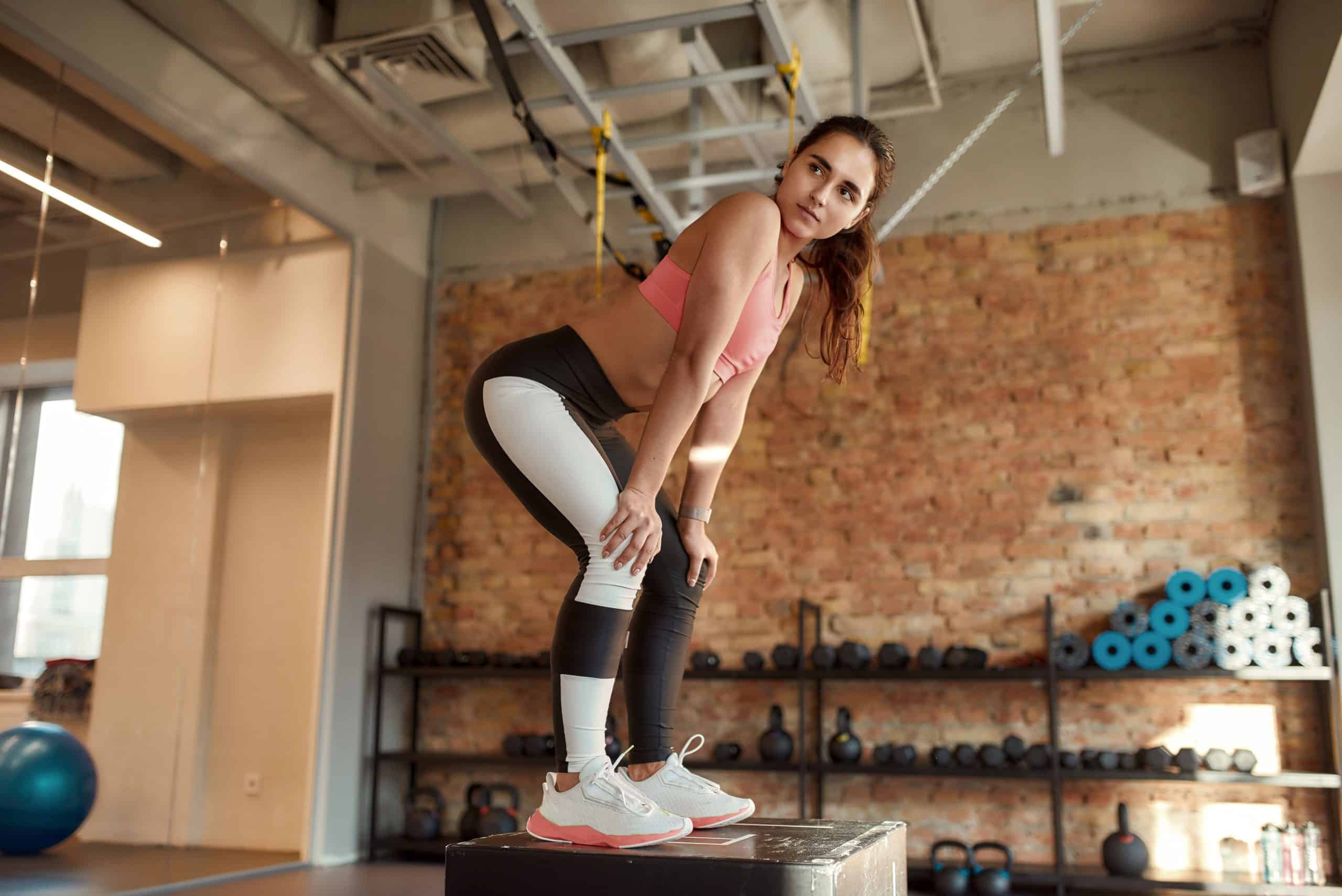The Greek word “pleythyein” means to increase or to augment. “Plyometrics” is a type of exercise that uses this definition as its foundation. In plyometrics, you push yourself to generate maximum force in the shortest amount of time possible. This type of exercise is also sometimes called “shock training.” Plyometric exercises are based on the stretch-shortening cycle. The stretch-shortening cycle is the process of stretching a muscle before contracting it. This type of exercise puts your muscles through this process over and over again, which leads to an increase in power, speed, agility, and explosiveness. Plyometric exercises are typically performed using your bodyweight, gravity, and momentum. However, you can also use equipment to help you with your plyometric training. One such piece of equipment is the plyometric box. A plyometric box is a sturdy, elevated platform that you can use for a variety of exercises. The most common exercises performed on a plyometric box are box jumps and box squats. However, there are many other exercises you can do as well, such as elevated push-ups and tricep dips. In this article, we’ll cover everything you need to know about plyometric boxes, including what they are, why you need one, and how to make your own.
Get your personalized
meal plan!
What Is A Plyometric Box?
A plyometric box is a three-sided box that is typically made out of wood, metal, or plastic. The sides of the box are usually between 12 and 36 inches tall.
The box is elevated off the ground, which allows you to use it for a variety of exercises that target your lower body, such as box jumps and box squats.
The height of the plyometric box will determine how challenging the exercise is. For example, a 12-inch box will be much easier to jump on than a 36-inch box.
Why You Need A Plyometric Box
There are many benefits to using a plyometric box in your workouts. Here are just a few:
Strengthen Fast-Twitch Fibers In The Muscles
Your muscles are made up of slow-twitch and fast-twitch muscle fibers. Slow-twitch fibers are responsible for endurance activities, such as long-distance running. Fast-twitch fibers are responsible for explosive activities, such as sprinting (1).
Plyometric exercises are designed to target fast-twitch muscle fibers. By increasing the size and strength of your fast-twitch fibers, you’ll be able to generate more power and explosiveness in your movements (5).
Increases The Efficiency Of The Neuromuscular System
What happens during plyometric training is that your muscles and nervous system learn to work more efficiently together. More specifically, your nervous system learns to fire more quickly, which results in your muscles contracting with greater force (3).
Improve Overall Athletic Performance
Plyometric training can help improve your overall athletic performance. If you’re a runner, you’ll be able to run faster and jump higher. If you play basketball, you’ll be able to dunk the ball with ease.
Overall, plyometric training will help you improve the following aspects of athleticism (4):
- Nimbleness/agility: this refers to your ability to change directions quickly.
- Reaction time: this is how quickly you can respond to a stimulus.
- Explosiveness: this is your ability to generate maximum force in the shortest amount of time possible.
- Speed: this refers to how fast you can move from one point to another.
- Coordination: this is your ability to use your different body parts together in a coordinated manner.
Reduce The Risk Of Injury
Plyometric exercises can also help reduce the risk of injury. This is because they train your muscles to absorb impact and generate force more effectively (4). By reducing the risk of injury, you’ll be able to stay active and healthy for years to come.
Read More: 100+ Fitness Affirmations That Will Help You Stay On Track
How To Make Your Own Plyometric Box
While these handy devices are available for purchase at many sporting goods stores, you can also save yourself some money by making your own plyometric box at home.
But first, let’s differentiate the types of plyometric boxes. They come in two different materials:
Foam Boxes
Are the most popular type of plyometric box. They’re made out of high-density foam and are very lightweight, which makes them easy to move around. They’re also relatively inexpensive. However, they’re not as durable as wood or metal boxes and can break down over time.
Wooden Boxes
Are the most durable type of plyometric box. They’re also the most expensive. But if you have the money to spend, a wooden box will last you a lifetime.
Plyo boxes also come in two different shapes:
Trapezoidal Boxes
They have four sides and a larger base than the top. These boxes are the most stable and therefore the safest to use. They are shaped in this way to protect your shins as you jump on and off the box.
BetterMe app is a foolproof way to go from zero to a weight loss hero in a safe and sustainable way! What are you waiting for? Start transforming your body now!
Rectangular/3-In-1 Boxes
These are straight up and down with no slanted sides. They’re not as stable as trapezoidal boxes and you could hurt your shins if you don’t jump high enough, but they’re more versatile because you can use them for a wider range of exercises.
They get their name from the fact that they have three different heights (20 inches, 24 inches, and 28 inches). They are extremely adaptable as you can switch up the height to target different muscle groups.
Now that you know the different types, let’s get into how to make a plyometric box. We’ll make a rectangular/3-in-1 box out of wood (2):
Tools And Materials Needed:
- Skilsaw or table saw
- Drill
- Measuring tape and straight edge
- Pencil
- (1) 8′ x 4′ piece of plywood that’s 3/4″ thick
- Gorilla glue
- Box of 2″ wood screws
How To Build A Plyometric Box:
Follow these steps to build your plyometric box:
Cut the plywood:
Using a skilsaw or table saw, cut the plywood into eight pieces that are:
- 2 pieces – 28″ x 20″ rectangles
- 2 pieces – 28″ x 22.5″ rectangles
- 2 pieces – 22.5″ x 18.5″ rectangles
- 2 pieces – 22.5″ x 20″ rectangles
Test the fit:
Take two of the rectangles and place them together at a 90-degree angle. The 22.5″ sides should be touching.
If they fit snugly together, then you can proceed to the next step. If not, make any necessary adjustments with your saw. You could also sand down the edges to make them fit better.
Drill pilot holes:
Once you have two rectangles that fit together snugly, drill four pilot holes into each rectangle. These will be used to attach the sides of the box together. Make sure to space them out evenly.
Read More: AMRAP Workouts Crossfit Style: Take Your Fitness Game To The Next Level
Apply glue and screw the sides together:
Apply a generous amount of Gorilla glue to the pilot holes and then screw the rectangles together using 2″ wood screws. Be sure to screw them in tightly so that the box is sturdy.
Repeat steps 3-4 for the remaining sides:
Once you have two sides of the box assembled, repeat steps 3-4 for the remaining sides.
Let the glue dry:
After you have all four sides of the box assembled, set it aside and let the glue dry for 24 hours.
Add finishing touches (optional):
Once the glue has dried, you can add any finishing touches you want, such as painting or staining the box. You can also add handles on the sides to make it easier to move around.
And that’s it! You now have a sturdy plyometric box that you can use for a variety of exercises. Get creative and see what kinds of workouts you can do with it. There are endless possibilities!
Which Workouts Can You Do With A Plyometric Box?
Now that you have your plyometric box, it’s time to put it to good use! Here are some ideas for workouts you can do with it:
Box Jumps
This is a classic plyometric exercise that targets your quads, hamstrings, and glutes. To perform a box jump:
- Place the box in front of you and stand with your feet hip-width apart.
- Bend your knees and swing your arms back, then jump up onto the box.
- Land softly on the box and immediately jump back down to the ground.
- Repeat for 10-12 reps.
Box Step-Ups
This is a great exercise for toning your legs and glutes. It’s also a great way to build up to box jumps if you’re not quite ready for them yet. To perform box step-ups:
- Place the box in front of you and stand with your feet hip-width apart.
- Step up onto the box with one leg, driving through your heel to stand up tall.
- Step back down with the same leg, and then repeat with the other leg.
- Alternate legs for 10-12 reps.
Intense sweat sessions, working weight loss tips, lip-smacking recipes come in one package with the BetterMe app. And all of it is at your fingertips, start transforming your life now!
Box Push-Ups
This is a great exercise for working your chest, shoulders, and triceps. It’s also a great way to make push-ups more challenging. To perform box push-ups:
- Place the box in front of you and get into a push-up position with your hands on the box.
- Your body should form a straight line from your head to your heels.
- Bend your elbows and lower your chest to the box, then push back up to the starting position.
- Repeat for 10-12 reps.
Bulgarian Split Squats
This is a great exercise for toning your legs and glutes. To perform Bulgarian split squats:
- Place the box behind you and stand with your feet hip-width apart.
- Lift one leg and place the top of your foot on the box.
- Keeping your core engaged, lower your body down until both legs are bent at 90-degree angles.
- Push back up to the starting position and repeat for 10-12 reps.
- Switch legs and repeat.
Box Dips
This is a great exercise for working your chest, shoulders, and triceps. It’s also a great way to make dips more challenging. To perform box dips:
- Place the box in front of you and sit on the edge with your hands on the box.
- Slide your butt off the edge of the box and lower your body down until your elbows are bent at 90-degree angles.
- Push back up to the starting position and repeat for 10-12 reps.
Decline Mountain Climbers
This is a great exercise for working your Abs, glutes, and quads. It’s also a great way to make mountain climbers more challenging. To perform decline mountain climbers:
- Place the box in front of you and get into a push-up position with your feet on the box.
- Your body should form a straight line from your head to your heels.
- Keeping your core engaged, raise one leg up off the box and bring your knee to your chest.
- Switch legs and repeat.
Box Jumps With Burpees
This is a great exercise for working your whole body. It’s also a great way to get your heart rate up and torch some calories! To perform box jumps with burpees:
- Place the box in front of you and stand with your feet hip-width apart.
- Bend your knees and swing your arms back, then jump up onto the box.
- Land softly on the box and immediately jump back down to the ground.
- As soon as you land, drop down into a push-up position.
- Quickly jump your feet up to meet your hands, then stand up and jump back onto the box.
- Repeat for 10-12 reps.
Box Jumps With Tuck Jumps
This is a great exercise for working your quads, hamstrings, and glutes. It’s also a great way to get your heart rate up and torch some calories! To perform box jumps with tuck jumps:
- Place the box in front of you and stand with your feet hip-width apart.
- Bend your knees and swing your arms back, then jump up onto the box.
- Land softly on the box and immediately jump back down to the ground.
- As soon as you land, bend your knees and jump up, tucking your knees into your chest.
- Land softly on the ground and repeat for 10-12 reps.
How Often Should You Use A Plyometric Box?
Plyometric boxes are a great way to add some variety to your workout routine. They can be used for both cardio and strength-training exercises. And, they’re relatively inexpensive and easy to find. However, plyometric exercises are high-impact and can be tough on your joints.
It’s best not to do them more than 2-3 times per week. If you’re new to plyometric exercises, start with 1-2 times per week and gradually increase your frequency as you become more accustomed to the movements.
In addition, take a few safety precautions when using a plyometric box. First, start with a lower box and work your way up to a taller one. This will help reduce the impact on your joints. Second, wear proper footwear.
Plyometric exercises are high-impact, so you’ll want to make sure you’re wearing shoes that can absorb the shock. Third, use a soft surface. If you’re doing box jumps, for example, make sure you’re jumping onto a mat or a soft surface to cushion your landing.
The Bottom Line
Plyometric boxes are a great way to add some variety to your workout routine. They can be used for both cardio and strength-training exercises. And, they’re relatively inexpensive and easy to find.
However, plyometric exercises are high-impact and can be tough on your joints. So, it’s best not to do them more than 2-3 times per week. Use the instructions in this article to build your own plyometric box and start reaping the benefits of this versatile piece of equipment!
DISCLAIMER:
This article is intended for general informational purposes only and does not serve to address individual circumstances. It is not a substitute for professional advice or help and should not be relied on for making any kind of decision-making. Any action taken as a direct or indirect result of the information in this article is entirely at your own risk and is your sole responsibility.
BetterMe, its content staff, and its medical advisors accept no responsibility for inaccuracies, errors, misstatements, inconsistencies, or omissions and specifically disclaim any liability, loss or risk, personal, professional or otherwise, which may be incurred as a consequence, directly or indirectly, of the use and/or application of any content.
You should always seek the advice of your physician or other qualified health provider with any questions you may have regarding a medical condition or your specific situation. Never disregard professional medical advice or delay seeking it because of BetterMe content. If you suspect or think you may have a medical emergency, call your doctor.
SOURCES:
- Fast-Twitch Vs. Slow-Twitch Muscle Fiber Types + Training Tips (n.d., nasm.org)
- How to Make a 3-in-1 Plyometric Box (2015, artofmanliness.com)
- Plyometric training and its effects on the neuromuscular system (2020, rowan.edu)
- Plyometrics: Developing Power With Plyometric Exercises (n.d., nasm.org)
- Preferential Type II Muscle Fiber Damage From Plyometric Exercise (2012, nih.gov)












